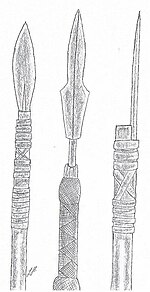Sumpitan
| Sumpitan | |
|---|---|

|
|
| Information | |
| Weapon type: | Blowpipe, lance |
| Designations: | Sumpitan, (see text) |
| Use: | weapon |
| Region of origin / author: |
Borneo / Kenyah , Dayak and others |
| Distribution: | Borneo |
| Overall length: | about 150 cm to about 240 cm, diameter about 7 cm to about 10 cm |
| Handle: | Wood |
| Lists on the subject | |
The Sumpitan (also Leput , Lohinglambi , Spioet , Sumpit ) is a combination weapon (blowpipe and lance) from Borneo . It was used there by ethnic groups such as the Kenyah and other Dayak groups as a hunting and war weapon.
description


The Sumpitan is a blowpipe carved from a single piece of hardwood from the Niagang tree. The Niagang wood has straight fibers and is poor in knots. It has the shape of a simple, coarse stick that is usually about 156 cm to about 240 cm long. It is round and has a diameter of about 7 cm to about 10 cm. After cutting from a tree, it is usually edited on the spot or taken along for later editing. To manufacture the branch, it is clamped in a device in which it sits firmly, sits on the ground and cannot slip. A long iron drill or chisel is used to pierce the entire length of the branch. Remaining processing residues are flushed out of the pipe with water . The last piece of the pipe is drilled open from the opposite side. This step makes the pipe slightly crooked. A straightening is achieved by bending the pipe. When the pipe hole is finished, the inside is finely machined. Rattan strings are pulled back and forth through the pipe and fine grains of sand are added. The finest polishing is done with the help of clay .
A lance blade is attached to one end and wrapped with rattan cords at the attachment point on the pipe to provide a more secure hold. The lance tip is always forged from iron , but in some cases a tip made from ironwood (Eusideroxylon zwageri, family of the Lauraceae) has been used. On the side opposite the lance tip, a grain ( Indonesian kiahulon ) made of wood, bone or metal is often attached to better aim. A ring ( Damar in Indonesian ) made of tree resin is usually attached to the mouthpiece , which serves as a support for the lips .
The associated equipment consists of a quiver ( Indonesian Tolor or Tavang ), the arrows ( Indonesian Langa ), a pumpkin ( Indonesian Hung ) for storing small cones from the tips of trees that are attached to the end of the arrows. These serve to seal the pipe with the arrows so that the strongest possible launch can take place. Other tools and equipment are needed to transport poison ( Indonesian Ipoh ) on the arrows, to prepare it and to attach it to the arrowheads. The equipment also includes a small tool that is used to machine and fix the cones in the arrow ends. Bamboo or palm wood splinters serve as arrows, and the milky sap of the Upas tree as arrow poison (Upas Antiar) . If the skin is injured, the poison is deadly within seconds.
The arrows that are shot from the Sumpitan have a range of about 35 meters to about 54 meters. Accurate hits are only effective up to a distance of 20 to 25 meters. When fired, the arrows reach a speed of about 180 km / h. Birds and other small animals were hunted with the Sumipitan. The use in combat is also documented: 30 men of an early British expedition team fell victim to the Dayak when they shot the Europeans with poison arrows.
Individual evidence
- ↑ a b c John O'Bryan: A History of Weapons: Crossbows, Caltrops, Catapults & Lots of Other Things that Can Seriously Mess You Up , p. 218, 2013, ISBN 9781452124209 .
- ↑ a b c d e f Albert G. van Zonneveld: Traditional weapons of the Indonesian archipelago. C. Zwartenkot Art Books, Leiden 2001, ISBN 90-5450-004-2 , pp. 131-132.